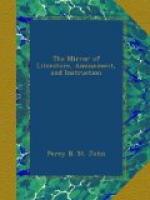But we must hasten to close our Notes on Gower—to proceed with our circuit of the coast:—West from Oxwich is Porteyron, where there is an extensive lobster and oyster fishery, near which is Landewy Castle. There is a wonderful precipice here. Further west we come to the village of Rossilly, near the Worms-Head, the termination of a range of rocks, which form the western point of the peninsula, being connected with it by a low isthmus. It extends more than a mile into the ocean, and at half-flood becomes an island. The name arose by mariners comparing it to a worm with its head erect, between the Nass Point and St. Gower’s Head, in Pembrokeshire. The scenery here is deeply interesting. This wild and desolate coast has proved fatal to numberless ships; the recent erection of the light-house on Caldy Island, near Tenby, on the opposite point of Carmarthen Bay, has, however, been most important. Several Indiamen have been wrecked here, and about fifty years since, a quantity of Spanish dollars, date 1625, were found amongst the sand, when the tide had receded unusually far, supposed to be part of the cargo of the “Scanderoon galley” lost on this coast nearly two centuries ago. This would do for the “Vigo Bay Company.” We proceed along the western shore of Carmarthen Bay, till we pass Whitford Point, a singular peninsula of sand, covered with reeds, which stands the fury of the tide, forming one side of the wide estuary of Barry, along the coast of which we pass a Roman encampment at Llanmadoc—the striking Castle of Llanridian, and other ruins, as we return eastward to Swansea; till we arrive at the village—we forget ourselves, the Borough of Castell Llwchyr, or Loughor, the Leucarum of Antoninus, and the fifth Roman station on the Via Julia. It




